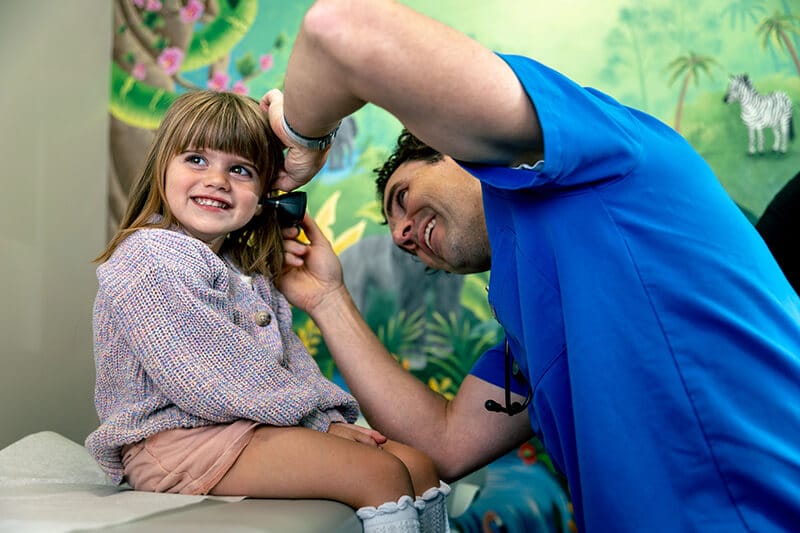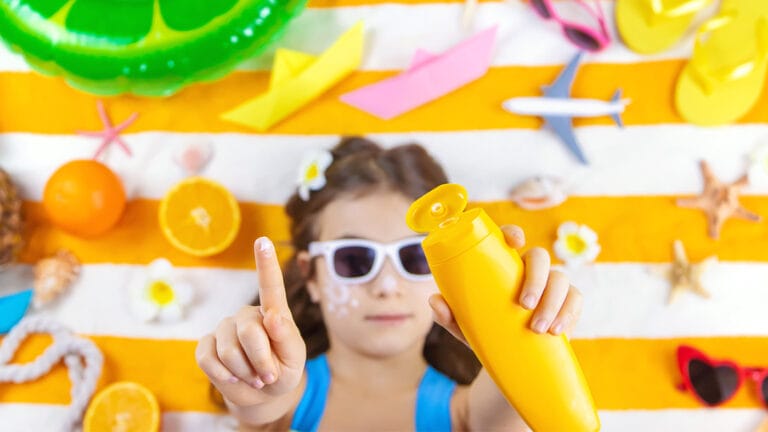The weather is warming up, and the days are getting longer. After a long winter, few things have felt better than the sun on my face, a fresh spring breeze, and the smell of blooming flowers.
There are many health benefits for children from being outdoors and enjoying the sunshine. These include improved emotional and physical well-being, reduction in childhood obesity, increased serotonin levels (which helps boost mood, gives you energy, and can help you stay focused), and vitamin D production (which is necessary for calcium and strong bones). Some recent studies show that children who spend more time outdoors have improved test scores, increased cognition, and self-discipline, and are less likely to suffer from behavioral problems. (Just What the Doctor Ordered: Using Parks to Improve Children’s Health)
That being said, let’s review some simple guidelines to help keep your little, or not-so-little ones, safe from sunburns while enjoying fun activities in the sun:
General Sun Safety:
- Try to keep infants under 6 months out of direct sunlight. Infants are at greater risk for heat exhaustion, heat stroke, and dehydration. Sunscreen is not recommended for babies under 6 months.
- Limit the sun exposure and take frequent breaks, especially between the peak sunlight hours of 10:00 a.m. to 4:00 p.m., when UV rays are the strongest
- Wear light, comfortable clothing that will block the sun’s rays, such as hats and sunglasses, or look for UV-protectant clothes.
- Don’t forget the sunscreen and reapply sunscreen often
Choosing a sunscreen:
- Higher SPF DOES NOT equal better sun protection. Sunscreen with SPF 30 is adequate for most people.
- Look for sunscreens that say ‘broad-spectrum’ on the label. This will offer protection from both UVA and UVB rays.
- Try to avoid sunscreens with oxybenzones and avobenzones if possible. However, if that is all you have then it is definitely better than no sunscreen at all.
- Sunscreens with zinc oxide and/or titanium dioxide offer the most sun protection. These can sometimes still be visible on the skin after application but are especially helpful for more sensitive areas such as the face, nose, ears, and shoulders.
Sunscreen should be applied liberally and repeatedly to optimize protection for all sun-exposed areas. Remember that even on overcast days, over 80% of the UV rays can get through the clouds, so it’s important to apply sunscreen every time your child is outside in the sun.
How to apply sunscreen:
- Timing is especially important. Sunscreen should be applied 15-30 minutes prior to sun exposure to allow a protective film to develop on the skin.
- Reapplication at least every 2 hours while outdoors is necessary. You can get sunburned more quickly when you’re swimming or boating because the reflection from the water makes the sun’s rays stronger.
- Sunscreen products labeled as “water resistant” only mean that the SPF is maintained after 40 minutes of activity in water or sweating. All sunscreens are washed off upon swimming or sweating, which is why frequent reapplication is needed.
Apply to all areas of the body but be careful around the eyes. If your child rubs sunscreen into their eyes, gently wipe the eyes and hands clean with a damp cloth. Older children can try blinking rapidly or moving their eyes around while their eyelids are closed. If you feel sunscreen irritates your child’s skin, try a different brand of sunscreen with titanium dioxide or zinc oxide. If a rash develops, take pictures and bring your child in for an examination of the rash.
Sunburns look bad and feel worse. They can cause blisters on the skin and can quickly ruin a fun day out in the sun. For moderate to severe sunburns, we recommend you bring your child into the office or seek medical care as soon as possible. For most kids, mild sunburns are self-limiting, last a few days, and can easily be managed at home. Home remedies are designed to relieve the pain and inflammation of the burned skin.
5 ways to soothe a sunburn at home:
- Replace lost fluids with water or 100% juice. Older children may prefer an electrolyte or sports drink.
- Cool compresses or soaks, calamine lotion, or aloe vera-based gels can provide some relief of pain and discomfort.
- Infants can use Tylenol as needed for pain control. Babies over 6 months can use either Tylenol or Motrin
- Emollients (Aquaphor, A/D ointment, Lanolin Cream, etc) can be used on intact skin for protection if tolerated. If blisters are present and rupture, they should be cleaned with mild soap and water and covered with wet or non-stick dressings.
- Keep your child out of the sun until the burn is fully healed and the pain and redness are gone.
The sun doesn’t have to be our enemy. If we remember to hydrate and protect ourselves, it just may be exactly the medicine we need after last year!!






